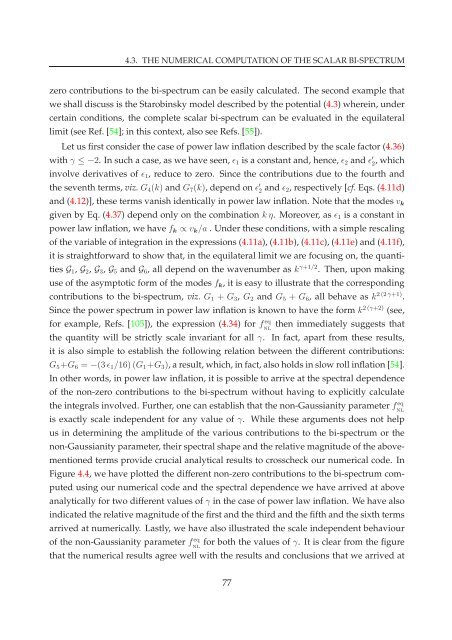PHYS08200605006 D.K. Hazra - Homi Bhabha National Institute
PHYS08200605006 D.K. Hazra - Homi Bhabha National Institute
PHYS08200605006 D.K. Hazra - Homi Bhabha National Institute
Create successful ePaper yourself
Turn your PDF publications into a flip-book with our unique Google optimized e-Paper software.
4.3. THE NUMERICAL COMPUTATION OF THE SCALAR BI-SPECTRUM<br />
zero contributions to the bi-spectrum can be easily calculated. The second example that<br />
we shall discuss is the Starobinsky model described by the potential (4.3) wherein, under<br />
certain conditions, the complete scalar bi-spectrum can be evaluated in the equilateral<br />
limit (see Ref. [54]; in this context, also see Refs. [55]).<br />
Let us first consider the case of power law inflation described by the scale factor (4.36)<br />
with γ ≤ −2. In such a case, as we have seen,ǫ 1 is a constant and, hence,ǫ 2 and ǫ ′ 2 , which<br />
involve derivatives of ǫ 1 , reduce to zero. Since the contributions due to the fourth and<br />
the seventh terms, viz. G 4 (k) and G 7 (k), depend on ǫ ′ 2 andǫ 2 , respectively [cf. Eqs. (4.11d)<br />
and (4.12)], these terms vanish identically in power law inflation. Note that the modesv k<br />
given by Eq. (4.37) depend only on the combination kη. Moreover, as ǫ 1 is a constant in<br />
power law inflation, we havef k ∝ v k /a . Under these conditions, with a simple rescaling<br />
of the variable of integration in the expressions (4.11a), (4.11b), (4.11c), (4.11e) and (4.11f),<br />
it is straightforward to show that, in the equilateral limit we are focusing on, the quantities<br />
G 1 , G 2 , G 3 , G 5 and G 6 , all depend on the wavenumber as k γ+1/2 . Then, upon making<br />
use of the asymptotic form of the modes f k , it is easy to illustrate that the corresponding<br />
contributions to the bi-spectrum, viz. G 1 + G 3 , G 2 and G 5 + G 6 , all behave as k 2(2γ+1) .<br />
Since the power spectrum in power law inflation is known to have the form k 2(γ+2) (see,<br />
for example, Refs. [105]), the expression (4.34) for f eq then immediately suggests that<br />
NL<br />
the quantity will be strictly scale invariant for all γ. In fact, apart from these results,<br />
it is also simple to establish the following relation between the different contributions:<br />
G 5 +G 6 = −(3ǫ 1 /16)(G 1 +G 3 ), a result, which, in fact, also holds in slow roll inflation [54].<br />
In other words, in power law inflation, it is possible to arrive at the spectral dependence<br />
of the non-zero contributions to the bi-spectrum without having to explicitly calculate<br />
the integrals involved. Further, one can establish that the non-Gaussianity parameterf eq<br />
NL<br />
is exactly scale independent for any value of γ. While these arguments does not help<br />
us in determining the amplitude of the various contributions to the bi-spectrum or the<br />
non-Gaussianity parameter, their spectral shape and the relative magnitude of the abovementioned<br />
terms provide crucial analytical results to crosscheck our numerical code. In<br />
Figure 4.4, we have plotted the different non-zero contributions to the bi-spectrum computed<br />
using our numerical code and the spectral dependence we have arrived at above<br />
analytically for two different values of γ in the case of power law inflation. We have also<br />
indicated the relative magnitude of the first and the third and the fifth and the sixth terms<br />
arrived at numerically. Lastly, we have also illustrated the scale independent behaviour<br />
of the non-Gaussianity parameter f eq for both the values of γ. It is clear from the figure<br />
NL<br />
that the numerical results agree well with the results and conclusions that we arrived at<br />
77
















